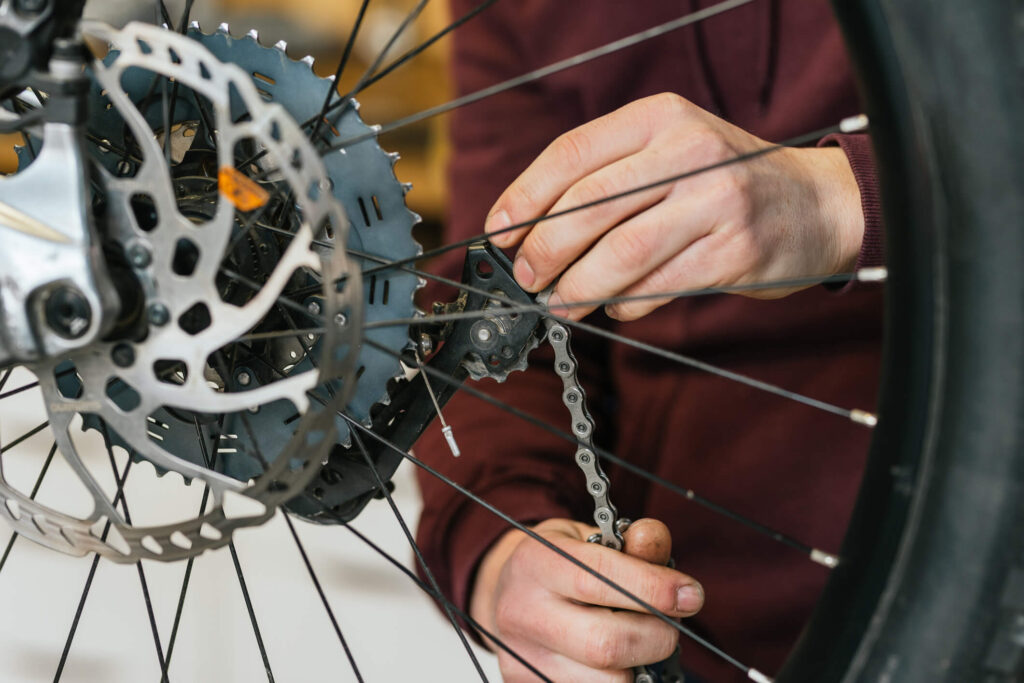Major Risks & Safety Concerns of E-Bikes
Injuries sustained by e-bikers are more similar to those of motorcyclists than regular bicyclists. There are many aspects that make e-bike use more dangerous and prone to these more damaging injuries.
Risk #1:
E-Bike Weight and Speed
E-bikes are much heavier than typical bikes, and travel at very high speeds. This can make simple falls more damaging to the rider because they are going very fast and the e-bike itself may injure them due to its weight.
The increased weight and speed of the e-bike can also lead to problems with hitting unseen pedestrians who aren’t able to move out of the way quickly enough, or being hit by cars that don’t expect a bike to approach so quickly.
Additionally, e-bikes are more difficult to stop quickly. This could cause injuries from events such as car doors opening without the rider being able to stop before hitting it.
Risk #2:
Rider Age
Young children are allowed to use Class I and II e-bikes, which can exceed speeds of 20 miles per hour. Because they don’t drive, children do not know the rules of the road. This lack of knowledge combined with such high travel speeds increases the risk of accidents with other vehicles or pedestrians. Young children may also have more trouble controlling the e-bike due to its weight.
Risk #3:
Poor Infrastructure
Some cities do not maintain the roads well, and uneven ground can cause any bicycle to skid or slip. The rider could fall over, or be thrown from the bike. Because of their high speeds and heavy weight, e-bikes in these situations could cause much more damage to the rider than an average bike would.
Additionally, few cities have dedicated bike lanes that are separated from other traffic by a physical barrier. This separation is recommended by ER doctors who treat the injuries caused by collisions of e-bikes with cars and other vehicles.
Risk #4:
Lack of Education & Training
E-bikes are currently treated nearly the same as regular bikes by the law. However, most e-bike riders will admit that an e-bike is not the same as a bicycle. There are nuances that must be learned by riding one, such as the increased weight and speed of the bike. Many parents and children don’t realize how different an e-bike is from its older counterpart, and thus don’t give it the appropriate amount of training and consideration to keep the riders (and others around them) safe.
Risk #5:
Neglecting Maintenance
Some accidents are caused by faulty parts made by the manufacturer, or by fires resulting from lithium ion batteries, usually ones that did not originally come with the bicycle. However, many incidents could be avoided by riders maintaining their e-bikes in proper condition. Neglecting to check for any damage, or deciding not to fix something that has broken can lead to accidents and injuries.
Risk #6:
Distraction & Recklessness
Distractions like wearing headphones in both ears or using a cell phone while riding can keep an e-bike rider from noticing the surroundings, increasing the likelihood of accidents. Reckless riding also brings many risks. This is the case on any type of bicycle, but for e-bikes, the risks become higher because they travel at high speeds, making them more difficult for both cars and pedestrians to avoid.
Risk #7:
Lack of Proper Safety Gear
E-bikes without any lights or reflectors in the dark are at high risk of being hit by a car that can’t see them. Additionally, many people do not wear helmets when they ride, which increases the risk of head injuries.
Injuries sustained by e-bikers are more similar to those of motorcyclists than regular bicyclists. There are many aspects that make e-bike use more dangerous and prone to these more damaging injuries.
Risk #1: E-Bike Weight and Speed

E-bikes are much heavier than typical bikes, and travel at very high speeds. This can make simple falls more damaging to the rider because they are going very fast and the e-bike itself may injure them due to its weight.
The increased weight and speed of the e-bike can also lead to problems with hitting unseen pedestrians who aren’t able to move out of the way quickly enough, or being hit by cars that don’t expect a bike to approach so quickly.
Additionally, e-bikes are more difficult to stop quickly, which could cause injuries from events such as car doors opening without the rider being able to stop before hitting it.
Risk #2: Rider Age

Young children are allowed to use Class I and II e-bikes, which can exceed speeds of 20 miles per hour. Because they don’t drive, children do not know the rules of the road. This lack of knowledge combined with such high travel speeds increases the risk of accidents with other vehicles or pedestrians. Young children may also have more trouble controlling the e-bike due to its weight.
Risk #3: Poor Infrastructure

Some cities do not maintain the roads well, and uneven ground can cause any bicycle to skid or slip. The rider could fall over, or be thrown from the bike. Because of their high speeds and heavy weight, e-bikes in these situations could cause much more damage to the rider than an average bike would.
Additionally, few cities have dedicated bike lanes that are separated from other traffic by a physical barrier. This separation is recommended by ER doctors who treat the injuries caused by collisions of e-bikes with cars and other vehicles.
Risk #4: Lack of Education & Training

E-bikes are currently treated nearly the same as regular bikes by the law. However, most e-bike riders will admit that an e-bike is not the same as a bicycle. There are nuances that must be learned by riding one, such as the increased weight and speed of the bike. Many parents and children don’t realize how different an e-bike is from its older counterpart, and thus don’t give it the appropriate amount of training and consideration to keep the riders (and others around them) safe.
Risk #5: Neglecting Maintenance

Some accidents are caused by faulty parts made by the manufacturer, or by fires resulting from lithium ion batteries, usually ones that did not originally come with the bicycle. However, many incidents could be avoided by riders maintaining their e-bikes in proper condition. Neglecting to check for any damage, or deciding not to fix something that has broken can lead to accidents and injuries.
Risk #6: Distraction & Recklessness

Distractions like wearing headphones in both ears or using a cell phone while riding can keep an e-bike rider from noticing the surroundings, increasing the likelihood of accidents. Reckless riding also brings many risks. This is the case on any type of bicycle, but for e-bikes, the risks become higher because they travel at high speeds, making them more difficult for both cars and pedestrians to avoid.
Risk #7: Lack of Proper Safety Gear

E-bikes without any lights or reflectors in the dark are at high risk of being hit by a car that can’t see them. Additionally, many people do not wear helmets when they ride, which increases the risk of head injuries.